2014陕旅版五年级英语unit 2 第三课时高效课堂教学设计
- 格式:doc
- 大小:26.00 KB
- 文档页数:2
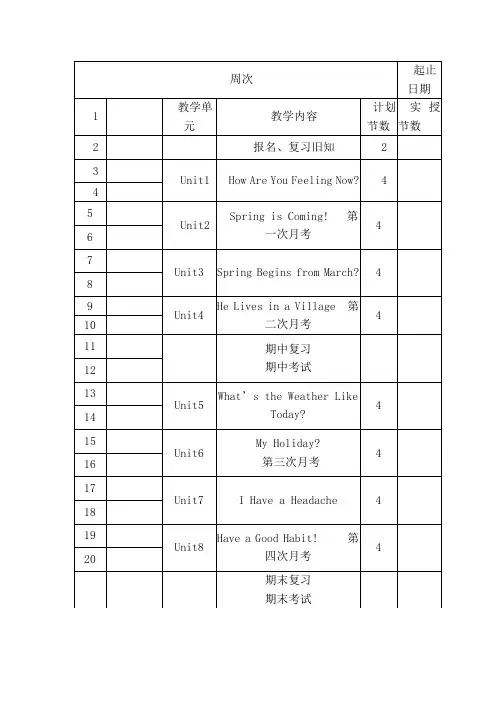
教材分析一、教材简况本套英语教材由陕西旅游出版社出版,是教育部审定的义务教育教科书。
根据教育部颁布的《全日制义务教育普通高级中学英语课程标准(实验稿)》规定的小学毕业应达到二级水平的要求精心编写的。
本教材供五年级使用。
本套教材吸取了最先进的外语教学理念和经验,从学生的学习兴趣、生活经验和认知水平出发,通过体验、实践、参与、合作与交流等学习方式,发展学生的综合语言运用能力,具有较强的科学性。
教材围绕最常用、最基本的英语词汇、句型和会话等编写,好教易学,具有较强的活动性和趣味性。
本教材根据小学生的年龄、心理特点和生活实践编写,同时注重激发和培养学生的学习语言的兴趣和信心。
有了兴趣和信心,学生们就有了积极进取的学习态度。
在本套教材中,提供了大量的生活情景,目的就是同学们可以在听听,做做,说说,玩玩,演演中学习单词,说句子,然后再将所学知识积极地运用到生活中去。
通过本教材的学习,一定能为将来的学习打下良好的基础。
本套教材中,我们设计了很多很实用的会话、有趣的游戏活动和故事、好听的歌曲和歌谣,并配上了精美的图画。
还有调皮的小精灵们会为大家的英语学习带来更多欢乐。
这些都会有利于培养学生的学习兴趣。
二、学生状况1.少数学生对英语有兴趣,口语运用自如、熟练。
2.大部分学生对英语学习有很大的自信心。
3.由于社会因素和家庭条件的影响,学生学习英语的环境不够理想。
三、教学重点1.教材共有8单元,每单元中都有要求学生熟记的单词和句型操练,力求在教学中熟练掌握。
2.听、说练习贯穿了整个教材,激发了孩子们在玩中听、说英语,是教材与教者共同始终追求的目标。
四、教学难度1.对单词和短语的熟记和完全掌握。
2.每个单元中出现的重点句型会说会用。
3.在学习过程中了解中西方文化的差异,大胆运用英语相互交流,进行简单对话。
4.激发学生的学习兴趣,加强学生听、说、读、写等基本技能。
教学总目标及任务第一单元 How Are You Feeling Now? 学习“四会”单词:feel happy, feel sad, feel tried, feel angry, go out to play, make a snowman. 并用所学单词和句型描述自己或他人的感受。
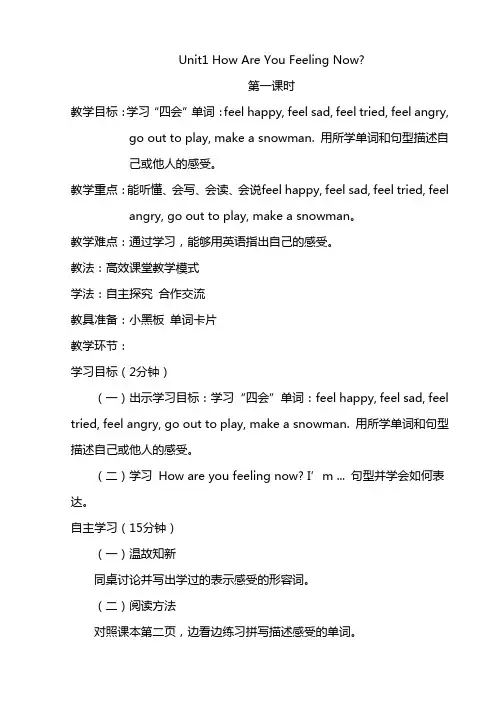
Unit1 How Are You Feeling Now?第一课时教学目标:学习“四会”单词:feel happy, feel sad, feel tried, feel angry, go out to play, make a snowman. 用所学单词和句型描述自己或他人的感受。
教学重点:能听懂、会写、会读、会说feel happy, feel sad, feel tried, feel angry, go out to play, make a snowman。
教学难点:通过学习,能够用英语指出自己的感受。
教法:高效课堂教学模式学法:自主探究合作交流教具准备:小黑板单词卡片教学环节:学习目标(2分钟)(一)出示学习目标:学习“四会”单词:feel happy, feel sad, feel tried, feel angry, go out to play, make a snowman. 用所学单词和句型描述自己或他人的感受。
(二)学习How are you feeling now? I’m ... 句型并学会如何表达。
自主学习(15分钟)(一)温故知新同桌讨论并写出学过的表示感受的形容词。
(二)阅读方法对照课本第二页,边看边练习拼写描述感受的单词。
(三)互助释疑同桌间一边做出各种表情,一边读出单词,交流不会读的单词。
(四)探究出招同桌间练习书写,可以互相检查拼写。
展示交流(10分钟)(一)小组展示小组内练习用英语描述感受(二)班级展示指名小组上讲台做游戏,用英语描述自己或者他人的感受。
点拨升华(8分钟)(一)教师放录音,学生跟读,纠正读音。
(二)学生开火车读单词。
(三)用句子How are you feeling now? I’m ... 同桌相互问答。
课堂作业(5分钟)•作业当堂清1.单词拼写feel h___ppy feel s___ d feel t_____ed feel ang___2. 英汉互译感到快乐_____________ feel sad ____________感到累______________ 感到生气_____________go out to play _______________ 堆雪人______________挑战自我How are you feeling now?I’m ...板书设计:Unit 1 How Are You Feeling Now?Happy feel sad tried, angry,go out to play, make a snowman第二课时教学目标:1、学习主系表结构的句型:主+系+表,即:人称+am/is/are+形容词2、句型学习How are you feeling now? I’m ...教学重点:熟练掌握句型,并进行简单的对话。
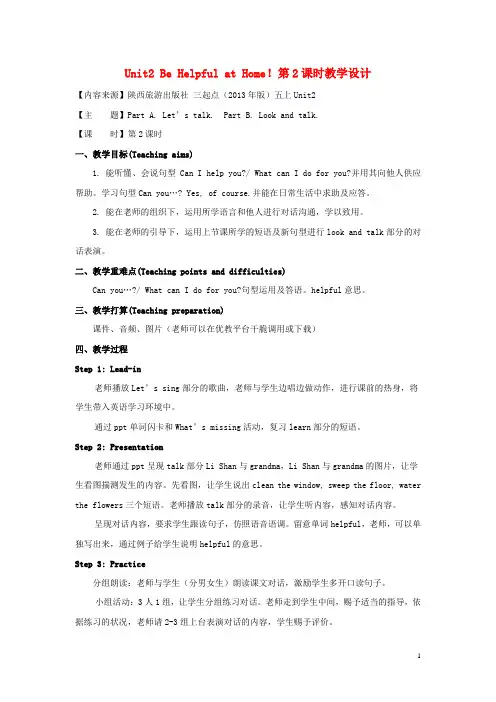
Unit2 Be Helpful at Home!第2课时教学设计【内容来源】陕西旅游出版社三起点(2013年版)五上Unit2【主题】Part A. Let’s talk. Part B. Look and talk.【课时】第2课时一、教学目标(Teaching aims)1. 能听懂、会说句型Can I help you?/ What can I do for you?并用其向他人供应帮助。
学习句型Can you…? Yes, of course.并能在日常生活中求助及应答。
2. 能在老师的组织下,运用所学语言和他人进行对话沟通,学以致用。
3. 能在老师的引导下,运用上节课所学的短语及新句型进行look and talk部分的对话表演。
二、教学重难点(Teaching points and difficulties)Can you…?/ What can I do for you?句型运用及答语。
helpful意思。
三、教学打算(Teaching preparation)课件、音频、图片(老师可以在优教平台干脆调用或下载)四、教学过程Step 1: Lead-in老师播放Let’s sing部分的歌曲,老师与学生边唱边做动作,进行课前的热身,将学生带入英语学习环境中。
通过ppt单词闪卡和What’s missing活动,复习learn部分的短语。
Step 2: Presentation老师通过ppt呈现talk部分Li Shan与grandma,Li Shan与grandma的图片,让学生看图揣测发生的内容。
先看图,让学生说出clean the window, sweep the floor, water the flowers三个短语。
老师播放talk部分的录音,让学生听内容,感知对话内容。
呈现对话内容,要求学生跟读句子,仿照语音语调。
留意单词helpful,老师,可以单独写出来,通过例子给学生说明helpful的意思。
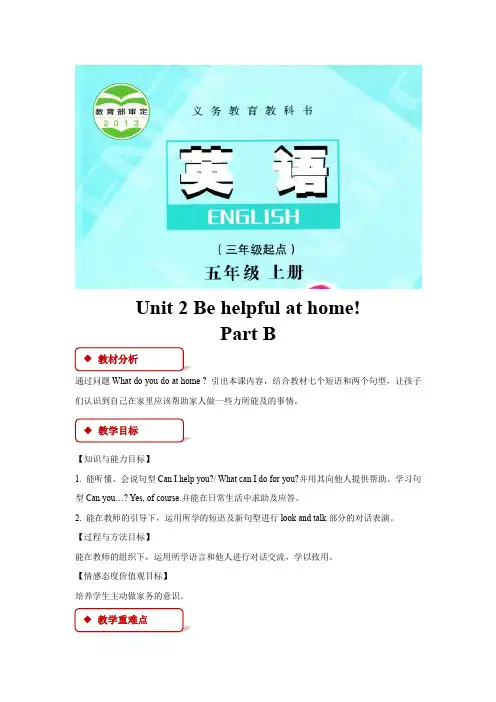
Unit 2 Be helpful at home!Part B通过问题What do you do at home ? 引出本课内容,结合教材七个短语和两个句型,让孩子们认识到自己在家里应该帮助家人做一些力所能及的事情。
【知识与能力目标】1. 能听懂、会说句型Can I help you?/ What can I do for you?并用其向他人提供帮助。
学习句型Can you…? Yes, of course.并能在日常生活中求助及应答。
2. 能在教师的引导下,运用所学的短语及新句型进行look and talk部分的对话表演。
【过程与方法目标】能在教师的组织下,运用所学语言和他人进行对话交流,学以致用。
【情感态度价值观目标】培养学生主动做家务的意识。
【教学重点】help sb do sth句型运用【教学难点】对于句型的灵活运用,对话的练习。
Tape recorder, MultimediaStep 1. Review and warm up1. The teacher plays the songs of Let's sing. The teacher and the students sing and do the exercises. They warm up before class and bring the students into the English learning environment.2. Through PPT and What 's missing activity, review some phrases.sweep the floor, do the dishes, clean the windows, water the flowers .Step 2. Practice1.Read aloud: the teacher and the students read the text aloud and encourage the students to read more sentences.Aunt: What can you do at home, Shanshan?Li Shan: I can make the bed.Aunt: What can you do dishes?Li Shan: Yes.I often help my mother do the dishes.Aunt: Can you help me cook the meal?Li Shan: Let me try.Aunt: Great!You are very helpful.2.Class activities: The teacher asks some questions, and let students answer.Class: Su Nan,Su Nan.What can you do at home.Miss White: What can he do?Class: He can sweep the floor.Miss White: Can you sweep the floor, Su Nan?Su Nan: Yes,of course.Step 3. Presentation1. The teacher can ask what can you do at home? Guide students to use I can... To answer, reinforce the phrase in the learn section. Teacher’s PPT shows all the pictures.2. The teacher asks Can you help me…? Guide students to answer. Let them understand the meaning of help sb do sth.Step 4. ExerciseThe teacher explains the activity requirements of choose, complete and talk to the students. Let the students complete the exercises on their own. Check the answers together.Step 6. Summary寻求帮助:Can you help me?向他人提供帮助:Can I help you?Step 5. Homework1. Prepare pictures of housework at home and upload them to class space2. Listen to the lecture on page 11.略。
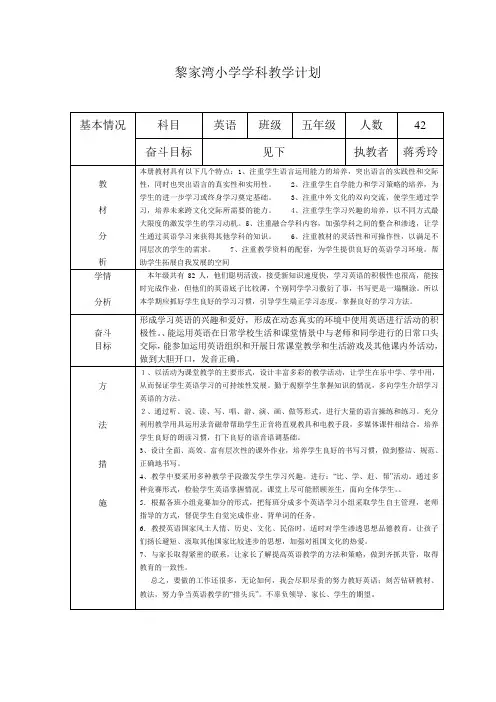
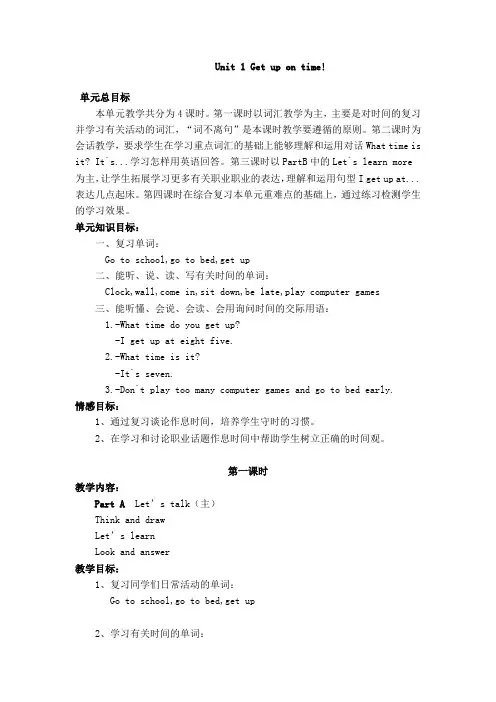
Unit 1 Get up on time!单元总目标本单元教学共分为4课时。
第一课时以词汇教学为主,主要是对时间的复习并学习有关活动的词汇,“词不离句”是本课时教学要遵循的原则。
第二课时为会话教学,要求学生在学习重点词汇的基础上能够理解和运用对话What time is it? It`s...学习怎样用英语回答。
第三课时以PartB中的Let`s learn more为主,让学生拓展学习更多有关职业职业的表达,理解和运用句型I get up at...表达几点起床。
第四课时在综合复习本单元重难点的基础上,通过练习检测学生的学习效果。
单元知识目标:一、复习单词:Go to school,go to bed,get up二、能听、说、读、写有关时间的单词:Clock,wall,come in,sit down,be late,play computer games三、能听懂、会说、会读、会用询问时间的交际用语:1.-What time do you get up?-I get up at eight five.2.-What time is it?-It`s seven.3.-Don`t play too many computer games and go to bed early.情感目标:1、通过复习谈论作息时间,培养学生守时的习惯。
2、在学习和讨论职业话题作息时间中帮助学生树立正确的时间观。
第一课时教学内容:Part A Let’s talk(主)Think and drawLet’s learnLook and answer教学目标:1、复习同学们日常活动的单词:Go to school,go to bed,get up2、学习有关时间的单词:Clock,wall,come in,sit down,be late,play computer games教学重点:能听懂、会说“What time is it? It`s...”日常用语。
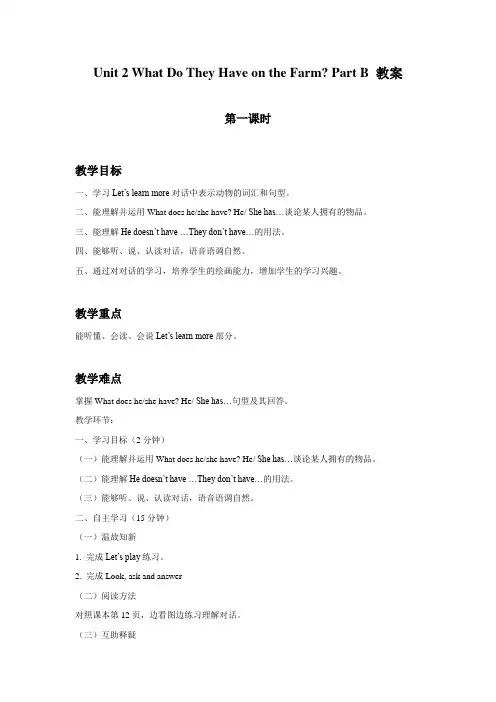
Unit 2 What Do They Have on the Farm? Part B 教案第一课时教学目标一、学习Let’s learn more对话中表示动物的词汇和句型。
二、能理解并运用What does he/she have? He/ She has…谈论某人拥有的物品。
三、能理解He doesn’t have …They don’t have…的用法。
四、能够听、说、认读对话,语音语调自然。
五、通过对对话的学习,培养学生的绘画能力,增加学生的学习兴趣。
教学重点能听懂、会读、会说Let’s learn more部分。
教学难点掌握What does he/she have? He/ She has…句型及其回答。
教学环节:一、学习目标(2分钟)(一)能理解并运用What does he/she have? He/ She has…谈论某人拥有的物品。
(二)能理解He doesn’t have …They don’t have…的用法。
(三)能够听、说、认读对话,语音语调自然。
二、自主学习(15分钟)(一)温故知新1. 完成Let’s play练习。
2. 完成Look, ask and answer(二)阅读方法对照课本第12页,边看图边练习理解对话。
(三)互助释疑同桌间读对话,理解名词单复数形式及动词的单数第三人称形式。
(四)探究出招小组合作用What does she/ he have in his/her box? 造句,并进行回答。
三、展示交流(10分钟)(一)小组展示小组内练习用英语问和答(组内成员文具盒里有什么?)(二)班级展示指名小组上讲台做游戏。
四、点拨升华(8分钟)(一)教师放录音,学生跟读,纠正读音。
注意句子的语音语调。
(二)小组内分角色相互进行对话练习。
(三)上台表演对话。
五、课堂作业(5分钟)(一)作业当堂清根据汉语补全短语。
1. three______(三只绵羊)2. two______(两个工人)3. my_____(我的妈妈)4. on the _______(在农场)5. a_____ _______(一个善良的警察).6. a ______ ________ (一名优秀的教师)(二)挑战自我用英语写一段你喜欢的动物。
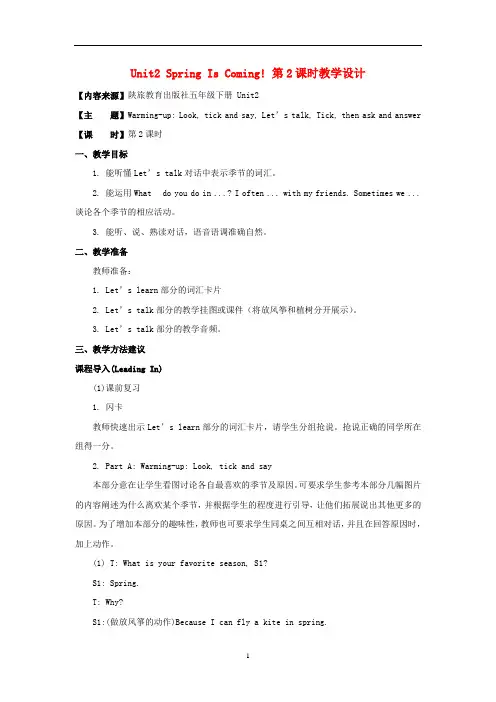
Unit2 Spring Is Coming! 第2课时教学设计【内容来源】陕旅教育出版社五年级下册 Unit2【主题】Warming-up: Look, tick and say, Let’s talk, Tick, then ask and answer 【课时】第2课时一、教学目标1. 能听懂Let’s talk对话中表示季节的词汇。
2. 能运用What do you do in ...? I often ... with my friends. Sometimes we ... 谈论各个季节的相应活动。
3. 能听、说、熟读对话,语音语调准确自然。
二、教学准备教师准备:1. Let’s learn部分的词汇卡片2. Let’s talk部分的教学挂图或课件(将放风筝和植树分开展示)。
3. Let’s talk部分的教学音频。
三、教学方法建议课程导入(Leading In)(1)课前复习1. 闪卡教师快速出示Let’s learn部分的词汇卡片,请学生分组抢说。
抢说正确的同学所在组得一分。
2. Part A: Warming-up: Look, tick and say本部分意在让学生看图讨论各自最喜欢的季节及原因。
可要求学生参考本部分几幅图片的内容阐述为什么离欢某个季节,并根据学生的程度进行引导,让他们拓展说出其他更多的原因。
为了增加本部分的趣味性,教师也可要求学生同桌之间互相对话,并且在回答原因时,加上动作。
(1) T: What is your favorite season, S1?S1: Spring.T: Why?S1:(做放风箏的动作)Because I can fly a kite in spring.(2) T: What is your favorite season, S2?S2: Summer.T: Why?S2:(做游泳的动作)Because I can swim in summer.(2)新课导入师生问答导人新课:T: What do you often do on Sunday, S3?S3: I often ...T: What do you often do on Monday, S3?S3: I often ...教师接下来提问另一位学生:T: What do you do in spring /... , S4?S4: I often ...教师指着另一位学生问:T: What about you, S5?S5: I often ...课程展示活动和过程的设计建议(presentation)(1)新课展示Part A: Let’s talk1. 教师出示放风筝的图片,提问学生:T: Look! What are they doing?Ss: They are flying kites.T: Do you fly kites in spring?Ss: Yes, I do.教师出示植树的图片,提问学生:T: Look! What are they doing?Ss: They are planting trees.T: Do you plant trees in spring?Ss: Yes, I do.教师接下来问某一位学生:T: Which is your favorite season, S1?S1: Spring / Summer / Autumn / Winter.T: So what do you do in ...?S1: I often ...教师接着问另一位学生:T: What about you, S2?S2: My favorite season is ... And I often ... in this season.T: Well. My favorite season is winter. I often make a snowman with my friends. Sometimes we throw snowballs.教师板书功能句:What do you do in ...?I often ... with my friends. Sometimes we ...2. 教师播放录音,让学生听并整体感知Let’s talk部分的对话。
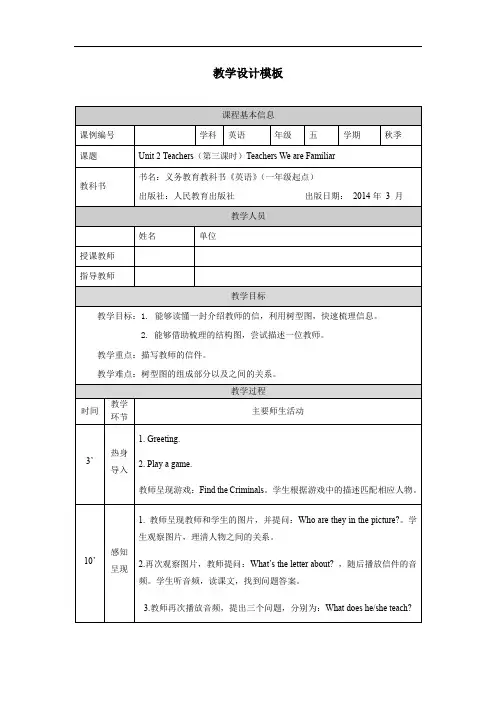
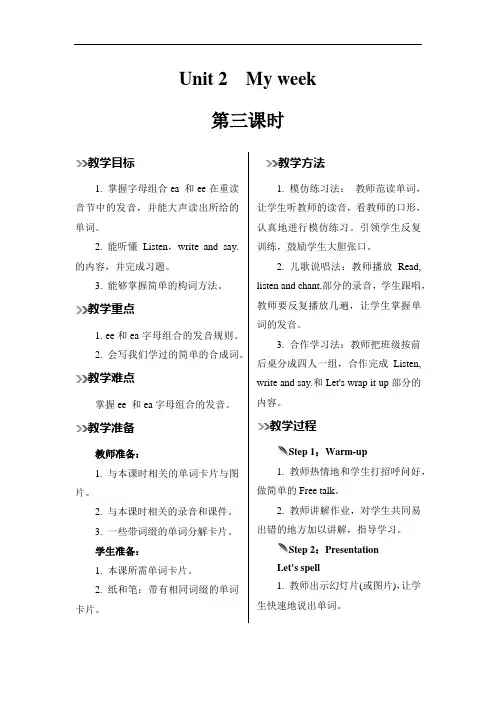
Unit 2 My week 第三课时教学目标1. 掌握字母组合ea 和ee在重读音节中的发音,并能大声读出所给的单词。
2. 能听懂Listen,write and say.的内容,并完成习题。
3. 能够掌握简单的构词方法。
教学重点1. ee和ea字母组合的发音规则。
2. 会写我们学过的简单的合成词。
教学难点掌握ee 和ea字母组合的发音。
教学准备教师准备:1. 与本课时相关的单词卡片与图片。
2. 与本课时相关的录音和课件。
3. 一些带词缀的单词分解卡片。
学生准备:1. 本课所需单词卡片。
2. 纸和笔;带有相同词缀的单词卡片。
教学方法1. 模仿练习法:教师范读单词,让学生听教师的读音,看教师的口形,认真地进行模仿练习。
引领学生反复训练,鼓励学生大胆张口。
2. 儿歌说唱法:教师播放Read, listen and chant.部分的录音,学生跟唱,教师要反复播放几遍,让学生掌握单词的发音。
3. 合作学习法:教师把班级按前后桌分成四人一组,合作完成Listen, write and say.和Let's wrap it up部分的内容。
教学过程Step 1:Warm-up1. 教师热情地和学生打招呼问好,做简单的Free talk。
2. 教师讲解作业,对学生共同易出错的地方加以讲解,指导学习。
Step 2:PresentationLet's spell1. 教师出示幻灯片(或图片),让学生快速地说出单词。
2. 教师出示单词卡片,让学生再次快速地说出单词:feet,beef,meet,read,tea,eat。
同时,教师纠正发音,并讲解发音规则和口型,然后归纳一些类似的字母或字母组合。
3. 图文配对活动教师边说单词边将图片贴在黑板上,然后让学生将单词卡片贴在相应的图片下。
4. 教师再次朗读以上单词,要求学生仔细听,看看这些单词都含有什么共同音素。
然后归纳并总结元音字母组合ea和ee发/i:/的一些单词。
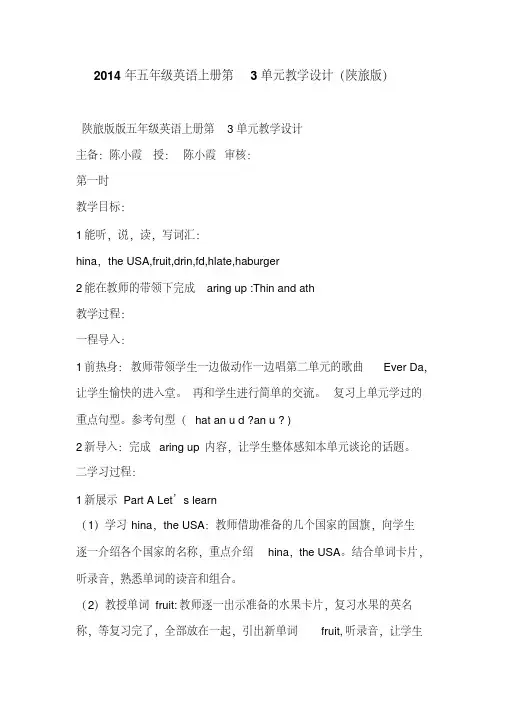
2014年五年级英语上册第3单元教学设计(陕旅版)陕旅版版五年级英语上册第3单元教学设计主备:陈小霞授:陈小霞审核:第一时教学目标:1能听,说,读,写词汇:hina,the USA,fruit,drin,fd,hlate,haburger2能在教师的带领下完成aring up :Thin and ath教学过程:一程导入:1前热身:教师带领学生一边做动作一边唱第二单元的歌曲Ever Da,让学生愉快的进入堂。
再和学生进行简单的交流。
复习上单元学过的重点句型。
参考句型(hat an u d ?an u ? )2新导入:完成aring up 内容,让学生整体感知本单元谈论的话题。
二学习过程:1新展示Part A Let’s learn(1)学习hina,the USA:教师借助准备的几个国家的国旗,向学生逐一介绍各个国家的名称,重点介绍hina,the USA。
结合单词卡片,听录音,熟悉单词的读音和组合。
(2)教授单词fruit:教师逐一出示准备的水果卡片,复习水果的英名称,等复习完了,全部放在一起,引出新单词fruit,听录音,让学生掌握发音技巧,教师适当点拨,引导拼读,识记单词。
引导学生造句,例如:hat fruit d u lie? D u lie fruit?(3)教授单词fd 和drin:教师通过以旧带新的方式,引出这两个单词。
通过实物展示,加深学生对这两个单词的记忆。
(4)教学hlate,haburger在教学hlate时,建议教师把单词划分成三个音节,让学生尝试着按音节拼读:h--late,注意单词重音;用同样的方式教学haburger。
()播放录音,学生跟读。
2巩固提高:(1)游戏(2)Flash ards三拓展:操练句型四精讲点拨五作业。
第二时教学目标:1能听懂,会说句型:hat’s ur favrite fd? favrite fd is /I lie best 以及The’re deliius,并能在相应的情境中熟练运用。
五年级英语学科导学案
设计人:何欢审核人:授课时间:2014-9-16 课题Unit 2 Be helpful at home. 课型新授授课人何欢
教
学内容1.能听懂Let’s learn more对话中表示家务活动的词汇和句型。
2.能理解并运用what can you do at home?谈论某人在家能干什么。
学
习目标1.能听懂Let’s learn more对话中表示家务活动的词汇和句型。
2.能理解并运用what can you do at home?谈论某人在家能干什么。
教
学重点1.能理解what can you do at home?I can...的用法。
2.能够听,说,认读对话,语音语调自然。
教
学
难
点
通过对对话的学习,培养学生的会话能力,增加学生的学习兴趣。
学
习
方
法
自主学习合作探究
教
学
准
备
录音带磁带
导学流程
演演演情景剧let’s talk.
说说复习what can you do at home? I can ...at home . 听听
播放let’s learn more 录音。
学生听并模仿语调。
练练
将学过的单词列在黑板上,学生将自己画的的卡片贴在相应的单词下面,并说出句子:I can.....在打叉的图片用But ,I can’t...练习说句子。
用用完成read and complete.
板书设计What can you do at home?
I can...
Let me try.
教后
补案
课后
反思
通过本课的学习,学生能模仿对话的结构,编出自己的对话。